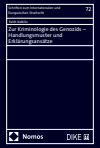Zusammenfassung
Die Untersuchung erhellt die wiederkehrenden Vorgehensweisen und Ursachen des Genozids. Erreicht wurde dies durch Urteilsanalysen von acht Verfahren zu 25 Angeklagten vor internationalen Strafgerichtshöfen. Über alle untersuchten Genozide hinweg stechen die Faktoren Bedrohungsszenarien, Autorisierung und Dehumanisierung hervor. Es ist eine Eigenschaft des Genozids, dass sich die gesellschaftlich dominante Bevölkerungsgruppe – meist die Mehrheit – von der genozidalen Opfergruppe bedroht fühlt. Der Genozid wird in diesem Zusammenhang als „Bedrohungsabwehr“ eingesetzt. Sowohl die Bedrohungsassoziation als auch der Bedrohungsgrad werden verstärkt, indem auf die Andersartigkeit der Opfergruppe verwiesen wird, wonach sie von Natur aus nicht anders könne, als die dominierende Bevölkerungsgruppe anzugreifen.
Abstract
The study sheds light on the recurring patterns and causes of genocide. This was achieved through analyses of judgements of eight trials of 25 defendants before international criminal tribunals. Across all genocides examined, the factors of threat scenarios, authorization, and dehumanization stand out. It is a characteristic of genocide that the dominant population - usually the majority - in society feels threatened by the genocidal victims. In this context, genocide is used as a "threat defense". Both the threat association and the degree of threat are reinforced by referring to the otherness of the victim group, according to which it cannot by nature do otherwise than attack the dominant population.
Schlagworte
Andersartigkeit authorization criminology Angeklagte Autorisierung defendants Bedrohungsabwehr defense against threat Bedrohungsassoziation dehumanization genocidal factors Bedrohungsgrad Bedrohungsszenarien genocidal victim group Dehumanisierung genocide international criminal courts Genozid Genozidfaktoren majority otherness Handlungsmuster internationale Strafgerichtshöfe patterns of action Kriminologie threat association Mehrheit threat scenarios Vorgehensweisen- 21–28 1 Einleitung 21–28
- 763–788 9 Schlussbetrachtung 763–788
- 789–812 Literaturverzeichnis 789–812
- 815–836 Anhang 2 – Codebuch 815–836

